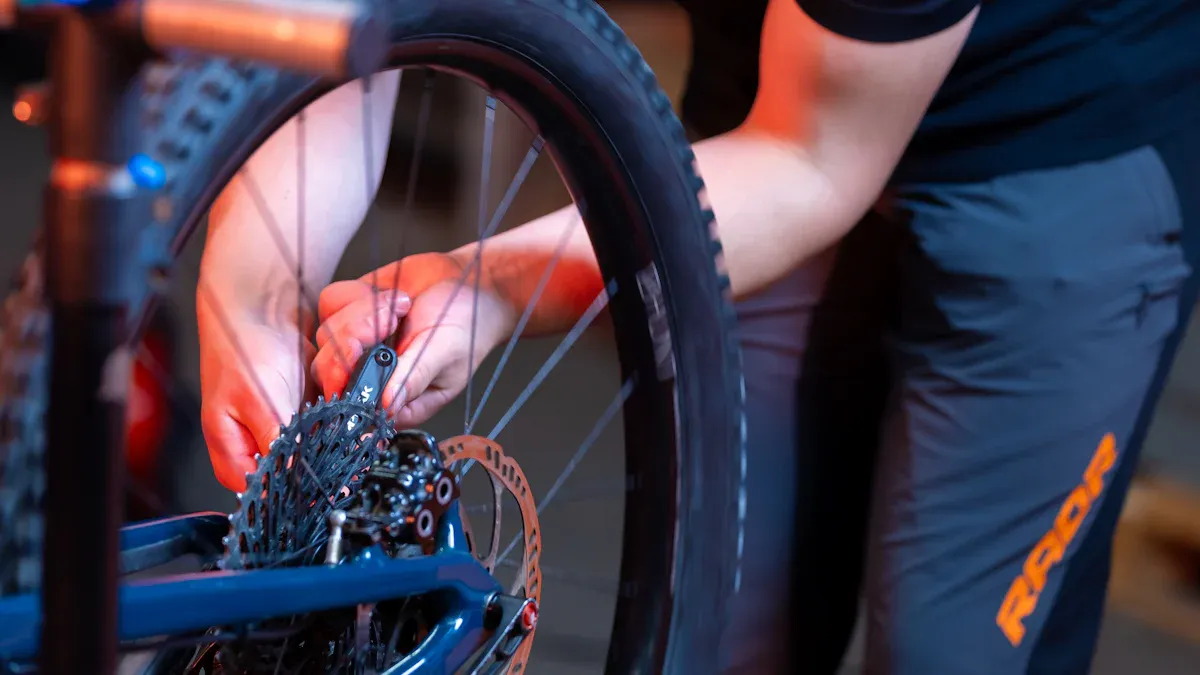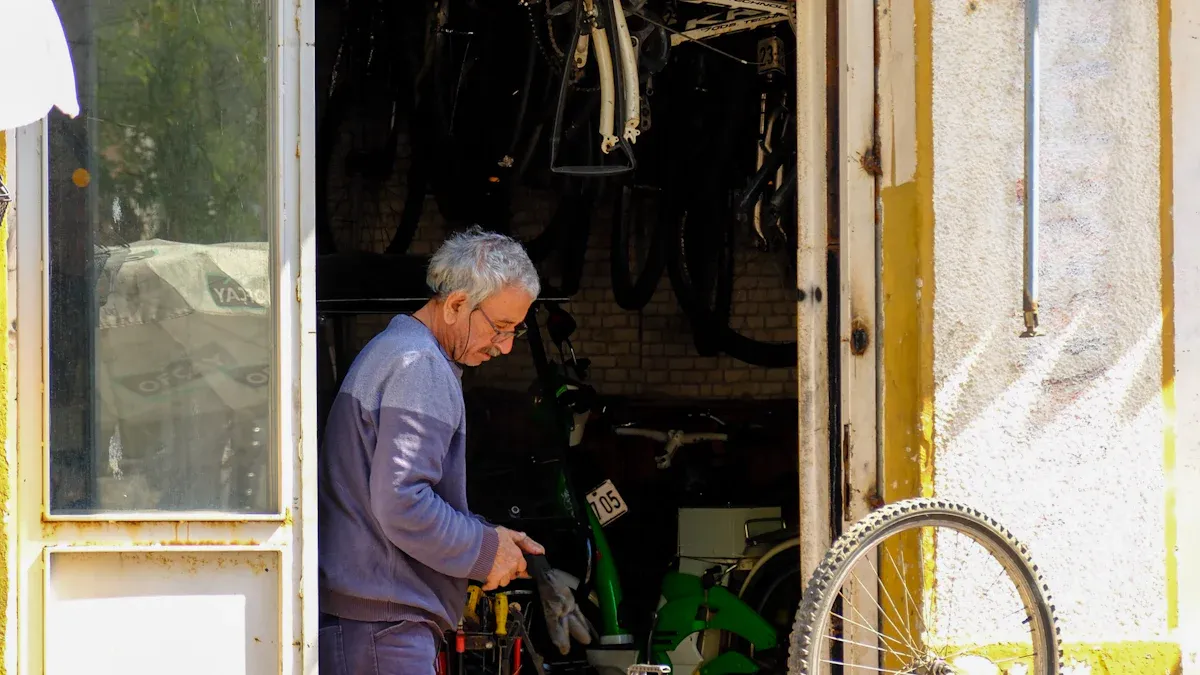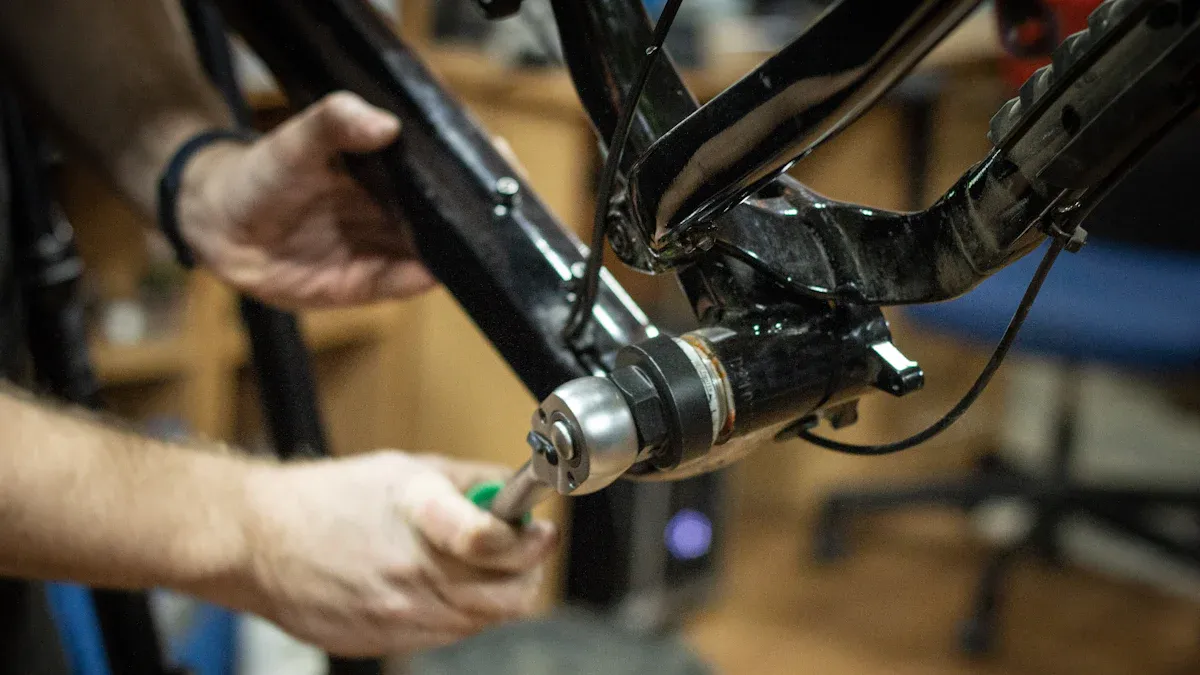
Maintaining your polished steel bike frame is very important. It helps with how it looks and how long it lasts. Polishing it often makes it shine more. It also helps stop rust and damage. A shiny bike makes you feel good and proud. If you ignore maintenance, big problems can happen. This includes serious breaks at the joints. So, keep your polished steel bike frame looking nice and riding safely!
Key Takeaways
Regularly polish your steel bike frame to enhance its shine and prevent rust. A well-maintained bike not only looks good but also lasts longer.
Use the right tools and products for polishing. Choose safe polishing compounds and eco-friendly cleaners to protect your bike’s finish.
Establish a maintenance routine. Clean your bike after each ride and inspect for damage to keep it in top shape and ready for the road.
Essential Tools for Polishing

When you polish your steel bike frame, having the right tools is very important. The right products help you get that shiny look and keep your bike safe from scratches.
Polishing Compounds
Polishing compounds are key for getting a mirror-like shine on your bike frame. They help remove small flaws and oxidation from the surface. Here are some popular choices that bike mechanics recommend:
PoliCraft stainless steel polishing kit: This kit has an arbor and three types of buffs and polishing compounds. It is useful for different polishing needs.
Using the right polishing compound can make your bike look better while protecting the metal underneath. Always pick compounds that are safe for steel to avoid damage.
Cleaning Products
Before you start polishing, clean your bike frame well. The right cleaning products are important because they should remove dirt without causing rust. Regular cleaning helps you find any weak spots in the paint, which is key for keeping the frame strong.
One great choice is Badass Bubbles, an eco-friendly cleaner made with help from professional teams. It cleans well while being safe for your frame material.
Tip: Always test a small area first to make sure the cleaning product doesn’t hurt the finish.
Besides these products, remember to wear safety gear. Gloves and goggles can keep you safe from chemicals and debris while you work.
With the right tools and products, you can keep your steel bike frame looking great. Regular maintenance not only improves its look but also makes it last longer.
Prepare to Polish a Steel Bike Frame
Before you start polishing your steel bike frame, you need to prepare it properly. This involves disassembling the bike and cleaning it thoroughly. Let’s break down these steps.
Disassembly Steps
Disassembling your bike allows you to inspect each part closely. Here’s how to do it:
Fully disassemble your bicycle to inspect and work on each part.
Use a component tray to organize small fixings and label them for reassembly.
Take plenty of photos during disassembly for reference later.
To remove crank arms, use a crank-puller tool. This tool screws into the crank arms and pulls them off the axle with a spanner.
Taking the time to disassemble your bike helps you avoid missing any areas that need attention during polishing.
Cleaning Techniques
Cleaning your bike frame is crucial before you polish a steel bike frame. A thorough cleaning prevents rust and extends the lifespan of your bike. Here are some effective cleaning techniques:
Gather supplies: polishing compound, clean rags, soft brush, and steel wool.
Wash the bike with soap and water to remove dirt and grime.
Dry the bike with a towel or cloth.
Use steel wool to scrub away rust spots.
Dust off the frame with a brush after rust removal.
Common contaminants include dirt, moisture, and rust spots. By cleaning well, you can also identify any weak spots on the paintwork. This step is essential for ensuring a smooth and shiny finish when you finally polish your bike.
Remember, a clean bike not only looks better but also rides better. So, take your time with this preparation!
Techniques for Polishing

When you want to polish your steel bike frame, you have two main choices: hand polishing and machine polishing. Each way has its own good and bad points. Let’s look at both to help you pick the best one for you.
Hand vs. Machine Polishing
Aspect | Hand Polishing | Machine Polishing |
|---|---|---|
Uses hand tools and your strength | Uses power tools to do the work | |
Efficiency and Speed | Slower, takes more time and effort | Faster, covers more area quickly |
Consistency | Pressure and motion can change | Gives more even results with steady moves |
Correction Abilities | Good for small fixes | Better at fixing deeper scratches |
Skill Requirements | Easy to learn | Needs more skill and practice |
Cost | Cheaper, needs fewer tools | Costs more because of power tools |
Hand polishing lets you control the process better. You can pay attention to spots that need more care. It’s also a good way to learn about your bike frame. But, it takes more time and work. On the other hand, machine polishing is quicker and can cover big areas fast. It’s great for fixing deeper scratches but takes more skill to use well.
Step-by-Step Polishing Process
Ready to start? Here’s a simple guide to help you polish your steel bike frame like a pro:
Take off any body panels that you don’t want to damage or polish. Use masking tape and newspaper to cover parts that will stay on the bike.
Remove the anodized finish by spraying oven cleaner on the area. Let it sit for 20-30 minutes before wiping it off. Do this again if needed until the area turns black.
Use aluminum oxide sandpaper, starting with 600 grit. Move to finer grits (800, 1000, 1500) to avoid deep scratches.
Put a spiral-sewn buff on your buffer and add Emory compound to start buffing. Use light pressure and move slowly and evenly.
Switch to Tripoli compound for a smoother finish. Follow the same buffing method to remove scratches and make it shine.
Following these steps will help you get a smooth finish while keeping it looking good and lasting long. Remember, patience is important! Take your time to make sure every part of your bike frame shines.
By picking the right polishing method and following these steps, you can keep your steel bike frame looking great and make it last longer. Happy polishing!
Apply Protective Coatings
After you polish your steel bike frame, putting on a protective coating is very important. This helps keep that shiny look and stops rust and wear. Let’s look at the types of coatings you can use and how to apply them well.
Types of Coatings
You have many choices for protective coatings. Here are some popular ones:
Rust Inhibitors: Products like Frame Saver™ or Boeshield T-9™ are very effective. They stop rust from forming inside your frame.
ED Coating: Electrophoretic deposition gives a strong shield against corrosion. It works well for hard-to-reach spots.
Powder Coating: This makes the frame thicker and stronger, so it resists chips and scratches.
Each type has its own benefits, so think about your riding conditions when picking one.
Application Tips
To get the best results from your protective coating, follow these steps:
Clean the Frame: Make sure the surface is clear of dirt and grease.
Apply the Coating: Use a rust inhibitor inside the frame at least once a season. If it’s wet, do this more often.
Inspect Regularly: Look for paint chips and fix them with touch-up paint.
Reapply Annually: If you ride in tough conditions, think about treating your frame twice a year.
Tip: For the best coverage, take off the headset and bottom bracket. This lets you spray into vent holes, making sure the coating gets to all moisture-prone areas.
By using the right protective coating, you can keep your bike frame looking good and make it last longer. Remember, regular maintenance is important for enjoying your ride!
Regular Maintenance for Polished Frames
To keep your polished steel bike frame looking its best, you need a solid maintenance routine. Regular cleaning and knowing when to re-polish are key to preventing rust and maintaining that shiny finish.
Cleaning Routine
Start with a simple cleaning routine to keep your bike frame in top shape. Here’s what you can do:
Wipe Down Regularly: Use a soft cloth to remove dirt and moisture after each ride. This prevents rust from forming.
Use Bike Protect: This product is great for maintaining the shine of polished steel. It drives out moisture and dirt, leaving a sparkling finish. Plus, its high oil content creates a protective layer that keeps dirt from sticking.
Inspect for Damage: While cleaning, check for any chips or scratches in the paint. Addressing these early can save you from bigger issues later.
Re-polishing Schedule
Knowing when to re-polish your bike frame is crucial. Here are some signs that indicate it’s time to polish again:
If you notice dull spots or a lack of shine, it’s time to polish.
Look for areas where the paint is chipped. Waxing these spots can provide temporary protection until you can re-polish.
Regular maintenance helps you identify when re-polishing is necessary. Aim to polish your frame at least once a year, or more often if you ride in harsh conditions.
By following these tips, you can maintain the polished finish of your bike frame and enjoy a ride that looks as good as it performs!
Polishing your steel bike frame boosts its appearance and protects it from rust. Regular maintenance not only keeps your bike looking sharp but also enhances its resale value. Remember, a well-maintained bike stands out. So, enjoy the process of polishing and take pride in your ride! 🚴♂️
A polished frame shines and attracts attention.
By following these tips, you’ll keep your bike in top shape for years to come!
FAQ
What’s the best way to clean my steel bike frame before polishing?
Use soap and water to wash it. Then, dry it thoroughly to prevent rust.
How often should I polish my bike frame?
Aim to polish at least once a year. More often if you ride in harsh conditions.
Can I use regular car polish on my bike frame?
No, avoid car polish. Use products specifically designed for steel to prevent damage.
See Also
Essential Tips for Caring for Your Steel Bicycle Frame
Proven Methods to Eliminate Rust from Your Bike Frame
Easy Strategies to Safeguard Your Bicycle Frame
